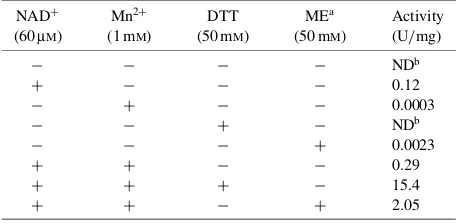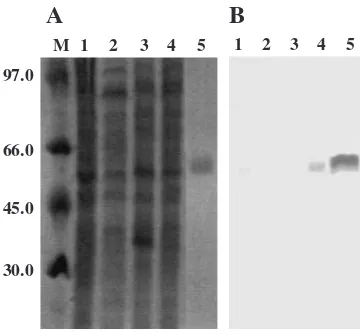Characterization of
Bacillus halodurans
-Galactosidase Mel4A Encoded
by the
mel4A
Gene (BH2228)
Andian Ari ANGGRAENI,
1;*Makiko SAKKA,
1Tetsuya KIMURA,
1Khanok RATANAKHAOKCHAI,
2Motomitsu KITAOKA,
3and Kazuo SAKKA
1;y1Applied Microbiology Laboratory, Graduate School of Bioresources, Mie University,
1577 Kurima-Machiyacho, Tsu 514-8507, Japan
2
School of Bioresources and Technology, King Mongkut’s University of Technology Thonburi, Bangkok 10140, Thailand
3
National Food Research Institute, 2-1-12 Kannondai, Tsukuba 305-8642, Japan
Received April 10, 2008; Accepted June 2, 2008; Online Publication, September 7, 2008 [doi:10.1271/bbb.80242]
A family-4 -galactosidase Mel4A of Bacillus halo-durans was expressed in Escherichia coli and
charac-terized. Recombinant enzyme rMel4A depended on NADþ, some divalent cations such as Mn2þ, and reducing reagents such as dithiothreitol. rMel4A was active on small saccharides such as raffinose but not on highly polymerized galactomannan. Immunological analysis indicated that raffinose induced the production of Mel4A inB. halodurans.
Key words: Bacillus halodurans;-galactosidase; meli-biase; glycoside hydrolase; raffinose
-Galactosidases (-Gals; EC 3.2.1.22) are enzymes that catalyze hydrolysis of the -1,6-galactosidic link-ages from the non-reducing end in galactose-containing oligosaccharides, liposaccharides, and polysaccharides. Based on amino acid sequence similarity,-Gals have been classified in families 4, 27, 36, 57, and 110 of glycoside hydrolases (The CAZy database,http://www. cazy.org/).1) Bacterial -Gals are grouped mainly into families 4, 36, and 110 with some exceptions.
The complete genome sequence ofBacillus halodur-ans C-125 revealed the presence of three putative -Gal genes: BH2228 encoding an enzyme of family 4, BH1870 encoding an enzyme of family 27, and BH2223 encoding an enzyme of family 36.2) Family 4 of the glycoside hydrolases includes maltose-6-phosphate glucosidase (EC 3.2.1.122), -glucosidase (EC 3.2.1.20), 6-phospho--glucosidase (EC 3.2.1.86), and -glucuronidase (EC 3.2.1.139) in addition to -galactosidase (EC 3.2.1.22) (http://www.cazy.org/). Among family-4 enzymes, however, there is little
information on-Gal. Although MelA fromEscherichia coli K-12 was purified and the analysis of its struc-ture such as amino acid composition and N-terminal amino acid sequence was carried out, no fundamental enzyme properties of MelA were reported.3) Hence, we chose BH2228, named mel4A, for biochemical characterization.
The mel4A gene (BH2228, DDBJ accession no. BA000004) was amplified by PCR using KOD DASH DNA polymerase (Toyobo, Osaka, Japan) and a primer set, 50 -GCGCGCTAGCATGGGAAAGATTACATTT-CTTGG-30 and 50-CGCGGTCGAC TTATTTGAAGG-ACTGTAGCCAGC-30, containing NheI and SalI rec-ognition sites (underlined) from B. halodurans C-125 (=JCM9153) genomic DNA as the template. The amplified DNA fragment was ligated into pT7Blue and introduced into E. coli XL1-Blue by a standard transformation protocol. A plasmid purified from a recombinant clone was digested withNheI andSalI and the inserted DNA fragment was recovered from an agarose gel and ligated between theNheI andSalI sites of pET-28a(+), yielding pET28a(+)-Mel4A. E. coli
BL21(DE3) harboring pET28a(+)-Mel4A was used in the production of the recombinant Mel4A (rMel4A).
E. coli BL21(DE3) harboring pET28a(+)-Mel4A was grown overnight at 37C in 500 ml of LB broth contain-ing kanamycin (60mg/ml). Isopropyl--D -thiogalacto-pyranoside was added to the culture to give a final concentration of 1 mM, and the culture was incubated for a further 20 h at 20C. Cell-free extract was prepared by ultrasonication of the cells, and was used as the crude enzyme solution in the purification of rMel4A with a HiTrap Chelating HP column (Amersham Biosciences,
* Present address:Faculty of Engineering, State University of Yogyakarta, Yogyakarta 55281, Indonesia
y To whom correspondence should be addressed. Tel: +81-59-231-9621; Fax: +81-59-231-9684; E-mail: sakka@bio.mie-u.ac.jp
Abbreviations: DTT, dithiothreitol;-Gal,-galactosidase;pNP,p-nitrophenol;pNP-Gal,p-nitrophenyl--D-galactopyranoside; PCR, polymerase chain reaction; Tris, Tris(hydroxymethyl)aminomethane
Biosci. Biotechnol. Biochem.,72(9), 2459–2462, 2008
Piscataway, NJ) according to the supplier’s protocol. Active fractions were collected and desalted by dialysis against 100 mM Tris–HCl buffer (pH 7.4) containing 60mM NADþ, 1 mM Mn2þ, and 1 mM dithiothreitol (DTT). Purified enzyme showed a single band with a molecular mass of 51 kDa on a gel of SDS-polyacryl-amide gel electrophoresis (data not shown).
Enzymes classified in family 4 of the glycoside hydrolases are known to require NADþ, Mn2þ ion, and reducing agents for maximum activity.4–6)To determine the nucleotide, metal ion, and reducing agent require-ments of rMel4A, the enzyme activity was measured withp-nitrophenyl--D-galactopyranoside (pNP-Gal) as the substrate in 100 mM Tris–HCl buffer (pH 7.4) containing combinations of these reagents. The reaction mixture was incubated at 37C for 5 min, and the reaction was stopped by the addition of borate buffer (pH 9.8). The amount of pNP released from pNP-Gal was measured by the absorbance at 405 nm. One unit of activity was defined as the amount of enzyme that liberates 1mmol of pNP per min from pNP-Gal under
the given assay conditions. Among NADþ, NADPþ, NADPH, and NADH, NADþstrongly activated rMel4A activity and NADPþshowed a slight activating effect, in that the effect of the latter was about 5% of that of the former (data not shown). Table 1 shows the specific activities of rMel4A in the reaction mixtures containing NADþ, the Mn2þ ion, and reducing agents at constant concentrations. Without the reagents, rMel4A showed no catalytic activity onpNP-Gal. Although the addition of one of these reagents slightly activated rMel4A, the enzyme was highly activated by the addition of these three reagents. The activating effect of DTT on rMel4A was stronger than that of mercaptoethanol. Although it was not possible to determine the effect of certain metal ions in the presence of DTT, since precipitates were formed, the Co2þ and Fe2þ ions showed a strong activating effect, as compared to that of Mn2þ in the presence of NADþ. The Ni2þand Zn2þions moderately enhanced rMel4A activity. As shown in Fig. 1, when rMel4A activity was assayed in reaction mixtures containing different amounts of one of NADþ, Mn2þ,
and DTT and constant amounts of the other two reagents, the enzyme was found to be heavily dependent on the concentration of each of these. The concentra-tions of NADþ, Mn2þ, and DTT required for the maximal activity of rMel4A were determined to be 0.2, 2, and 50 mM, respectively, indicating that NADþ, Mn2þ, and DTT were prerequisites for rMel4A activity. In all of the family-4 enzymes, a Cys residue located around the 160–175 positions of their respective sequences is conserved. Crystallographic study of -glucosidase AglA from Thermotoga maritima has
Table 1. Effects of NADþ, Mn2þ, and Reducing Agents on Enzyme
rMel4A activity was assayed with pNP-Gal in the presence of various concentrations of one of three reagents, NADþ, Mn2þ, and
DTT, and constant concentrations of two other reagents,viz., 60mM for NADþ, 1 mMfor Mn2þ, and 50 mMfor DTT.
indicated that a reduction in activity in the absence of DTT was due to oxidation of the SH group of the Cys-174 residue to Cys-SO2H, and that DTT was probably necessary to maintain Cys-174 in the reduced form.7) Crystal structure of phospho--glucosidase GlvA from
Bacillus subtilis indicated that Cys-171 was linked to Mn2þ.8)rMel4A showed weak activity towardpNP--D -glucopyranoside (0.6 U/mg) in addition to pNP-Gal. rMel4A hydrolyzed melibiose, raffinose, and stachyose, but not guar gum (highly polymerized galactomannan), and the Km and kcat values for these substrates were determined to be as follows: 1.6 mM and 16.3 s1
for pNP-Gal, 16.1 mMand 9.2 s1
for melibiose, 5.0 mMand 0.93 s1
for raffinose, and 39.1 mM and 1.3 s1 for stachyose. The values for stachyose were apparent, since raffinose is produced during hydrolysis of the original substrate, stachyose. rMel4A showed the highest kcat value on melibiose among the natural substrates. On the other hand, it showed higher affinity for raffinose than for melibiose or stachyose. the optimum pH and temperature of rMel4A were 7.4 and 37C. The enzyme was stable between pH 7 and 8 at 4C upon 24-h of incubation and stable at 40C for 10 min.
Western blot analysis using an anti-rMel4A antiserum identified an immunoreactive protein in intracellular proteins ofB. haloduransgrown in a medium containing raffinose as the carbon source (Fig. 2). Localization of Mel4A in the intracellular fraction was consistent with the apparent absence of a signal peptide sequence in Mel4A and the maximum activity of rMel4A in the neutral pH range despite the alkaliphilic property of
B. halodurans. It is interesting that only raffinose, and not melibilose or stachyose, induced expression of the
mel4Agene althoughB. haloduransgrew on these three
saccharides and purified rMel4A was active toward these substrates. Although this bacterium also utilized guar gum as a carbon source, the presence of guar gum did not induce production of Mel4A. It is likely that the hydrolysis of guar gum is carried out by-Gal(s) other than Mel4A, since at least two possible -Gal genes other thanmel4Acan be identified in theB. halodurans
genome, BH1870 encoding an enzyme of family 27, and BH2223 encoding an enzyme of family 36. Since some -Gals classified in family 27 are known to hydrolyze highly polymerized galactomannan,9)guar gum might be hydrolyzed by the family-27 -Gal. Complete degrada-tion of galactomannas requires the combined acdegrada-tion of endo-1,4--mannanase and -mannosidase, which hydrolyze the backbone of mannan, and -Gal, which releases the galactosyl groups. B. halodurans must produce mannan-degrading enzymes as well as -Gals. In this study, we successfully expressed and charac-terizedB. haloduransMel4A as a recombinant enzyme. Studies of the structure-function relationship of family-4 -Gal should be helpful for a better understanding of these unique enzymes.
Acknowledgments
This study was supported in part by Special Coordi-nation Funds for the Promotion of Science and Tech-nology from the JST-NRCT joint program of the Japan Science and Technology Agency (JST) and the National Research Council of Thailand (NRCT).
References
1) Henrissat, B., and Bairoch, A., Updating the sequence-based classification of glycosyl hydrolases.Biochem. J., 316, 695–696 (1996).
2) Takami, H., Nakasone, K., Takaki, Y., Maeno, G., Sasaki, R., Masui, N., Fuji, F., Hirama, C., Nakamura, Y., Ogasawara, N., Kuhara, S., and Horikoshi, K., Complete genome sequence of the alkaliphilic bacterium Bacillus halodurans and genomic sequence comparison with Bacillus subtilis. Nucleic Acids Res., 28, 4317–4331 (2000).
3) Nagao, Y., Nakada, T., Imoto, M., Shimamoto, T., Sakai, S., Tsuda, M., and Tsuchiya, T., Purification and analysis of the structure of-galactosidase fromEscherichia coli. Biochem. Biophys. Res. Commun.,151, 236–241 (1988). 4) Thompson, J., Hess, S., and Pikis, A., Genes malhand pagl of Clostridium acetobutylicum ATCC 824 encode NADþ and Mn2þ dependent phospho--glucosidases.
J. Biol. Chem.,279, 1553–1561 (2004).
5) Thompson, J., Gentry-Weeks, C. R., Nguyen, N. Y., Folk, J. E., and Robrish, S. A., Purification fromFusobaterium mortiferum ATC 25557 of a 6-phosphoryl-O--D
-gluco-pyranosyl:6-phosphoglucohydrolase that hydrolyzes mal-tose-6-phosphate and related phospho--D-glucosides.
J. Bacteriol.,177, 2505–2512 (1995).
6) Yip, V. L. Y., and Withers, S. G., Mechanistic analysis of the unusual redox-elimination sequence employed by Thermotoga maritima BglT: a 6-phospho--glucosidase
M 1 2 3 4 5 1 2 3 4 5
Fig. 2. Expression of Mel4A inB. halodurans.
Gels were stained with Coomassie brilliant blue (A). Mel4A on Western blot analysis was detected with a polyclonal mouse antiserum raised against purified rMel4A (B). Lane M, standard markers; lane 1, proteins in the culture supernatant ofB. halodurans grown on melibiose; lane 2, grown on guar gum; lane 3, grown on glucose; lane 4, grown on raffinose; lane 5, purified rMel4A.
from glycoside hydrolase family 4. Biochemistry, 45, 571–580 (2006).
7) Lodge, J. A., Maier, T., Lieble, W., Hoffmann, V., and Strater, N., Crystal structure ofThermotoga maritima -glucosidase AglA defines a new clan of NADþdependent
glycosidases.J. Biol. Chem.,278, 19151–19158 (2003). 8) Rajan, S. S., Yang, X., Collart, F., Yip, V. L. Y., Withers,
S. G., Varrot, A., Thompson, J., Davies, G. J., and
Anderson, W. F., Novel catalytic mechanism of glycoside hydrolysis based on the structure of an NADþ/Mn2þ
-dependent phospho--glucosidase fromBacillus subtilis. Structure,12, 1619–1629 (2004).
9) Jindou, S., Karita, S., Fujino, E., Fujino, T., Hayashi, H., Kimura, T., Sakka, K., and Ohmiya, K.,-Galactosidase Aga27A, an enzymatic component of the Clostridium josuicellulosome.J. Bacteriol.,184, 600–604 (2001).

